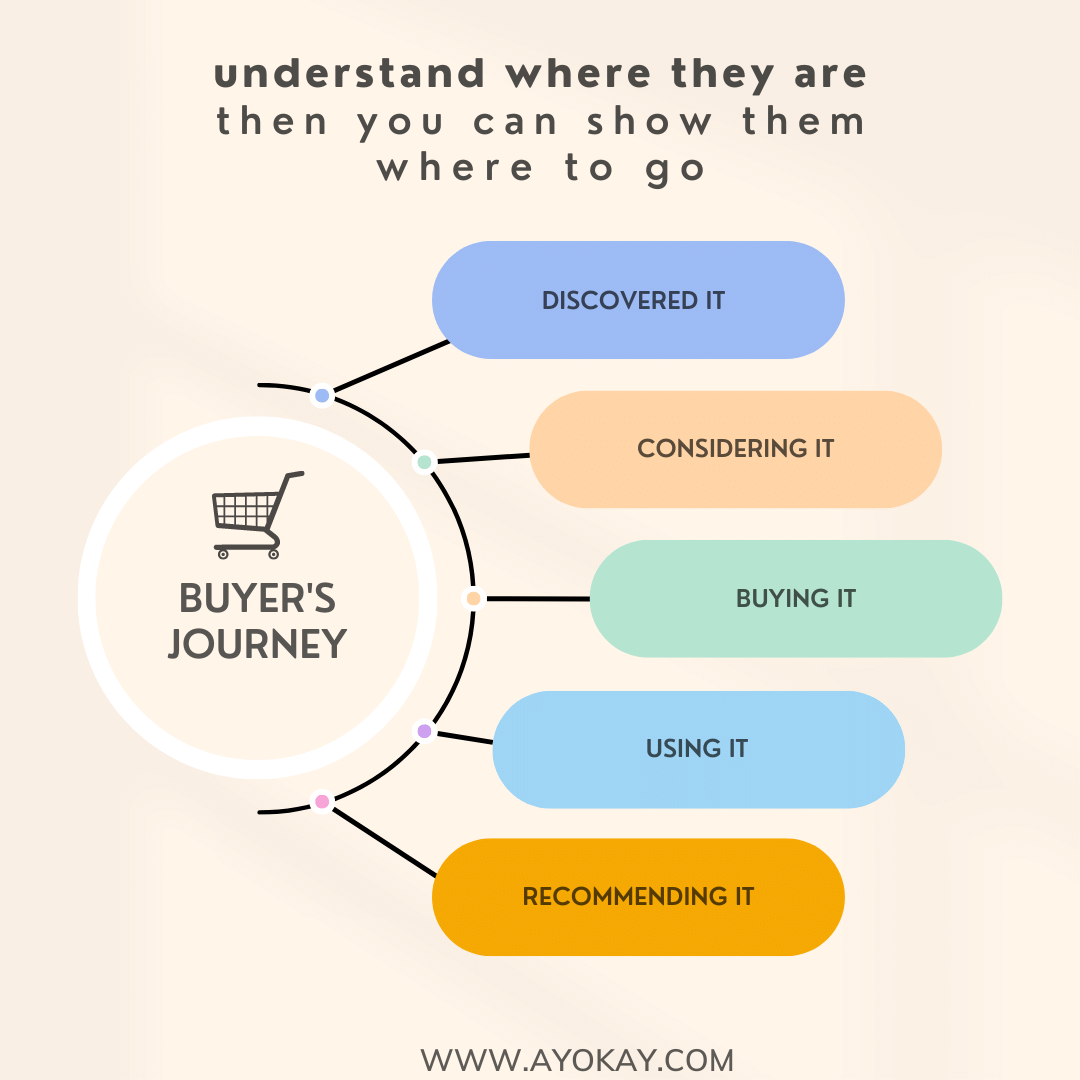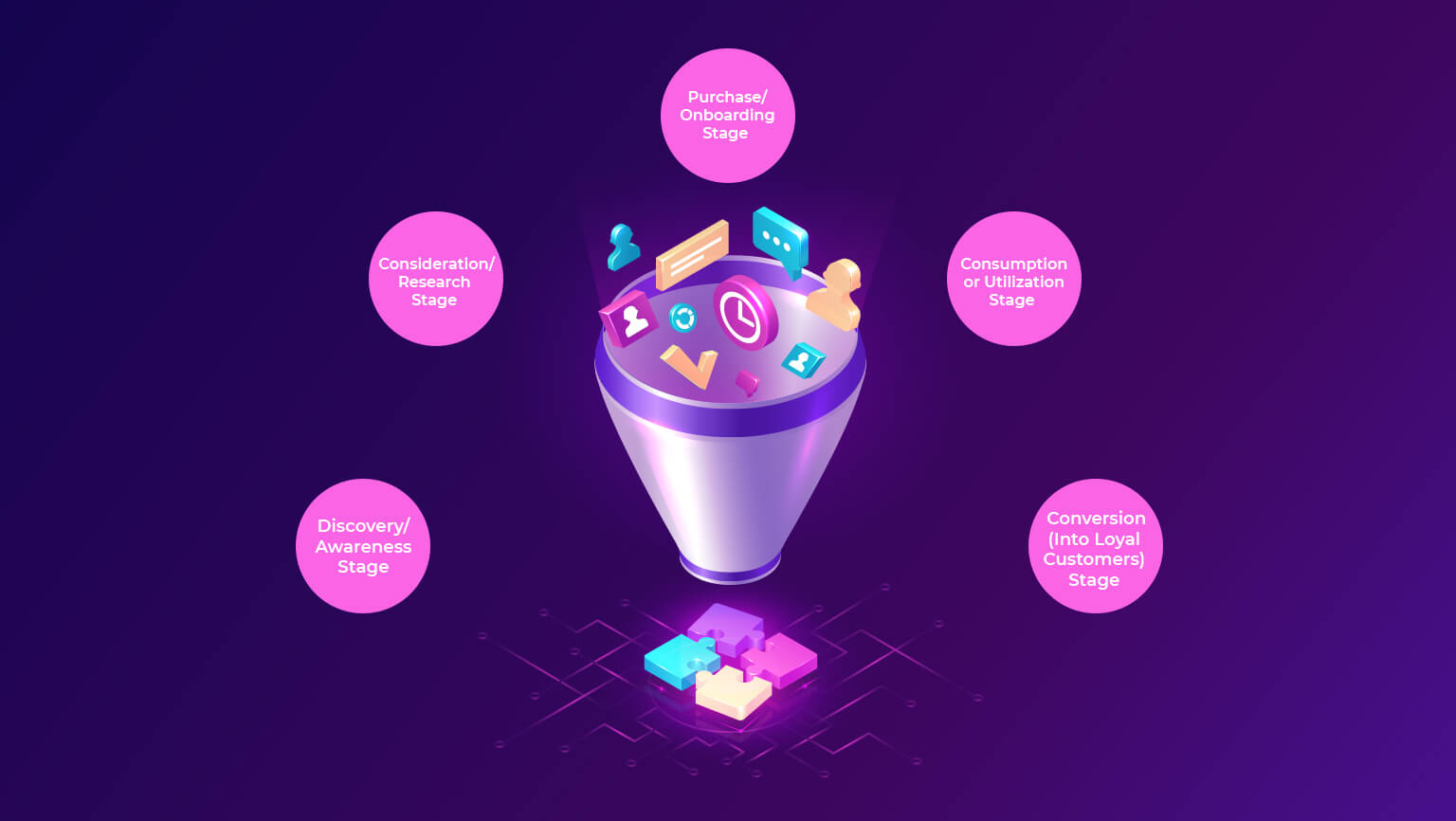Content marketing has come a long way over the years. An increasing number of businesses are focusing on creating valuable, relevant, and engaging content that cements expertise and provides solutions. However, content is more effective if it hits your prospects at the right stage of the sales funnel. That’s why nearly 77% of the most successful B2B marketers produce content based on specific stages of the buyer’s journey.
Every customer goes through the sales funnel. It usually involves the gradual transition of a potential buyer into a loyal customer.
But does this mean your content strategy should merely push customers through the sales funnel?
A B S O L U T E L Y N O T !
But you should guide your target audience through the buying cycle by gratifying their specific needs at every stage. Here’s how you can sync your content marketing efforts with the different stages of your sales funnel.
1. Defining the Buyer’s Journey
Usually, a sales funnel comprises the following stages:

A. Discovery/Awareness Stage
Your customer is just beginning their journey at this stage. They are aware of their problem and want a better understanding of it. They may have not heard of your brand or product at this stage. In some extreme cases, they might not even know what exactly the problem is. (Late-night infomercials were the undisputed champs at making people think there was a problem that needed solving.)
B. Consideration/Research Stage
By now, the user is researching, comparing and exploring options (or brands) that can solve their problem. They want a solution that fits their budget, expectations, and other requirements.
C. Purchase/Onboarding Stage
At this stage, the prospect is about to become a first-time buyer. But, they still need a little more information about your product/service before taking the plunge.
D. Consumption or Utilization Stage
At this stage, the user has already purchased your product/service. But, they may still encounter problems when using it and are looking for relevant solutions.
E. Conversion (Into Loyal Customers) Stage
This is the last stage where the prospect purchases your product/service more than once. They may also share their experience with others, encouraging them to try your product/service.
Depending on your industry, product, service, or client demographics, this funnel may look different. For example, buying a $20 tie may not require spending a lot of time researching, whereas purchasing a $50,000 car typically demands a lot of consideration.
2. Mapping Keywords for Each Stage
In-depth keyword research is at the heart of a content strategy that is synced with your sales funnel. People will always use specific keywords at each stage of the purchase cycle as they conduct research.
Start by using a basic keyword research tool to identify terms and phrases related to your broad offerings. Ubersuggest is a super user-friendly resource for this. Once you have expanded the list, remove the irrelevant keywords based on their search volume, competition, and other metrics. In regards to the keywords in different stages of your buyer’s journey, you can categorize them based on their intent.
For example, if you are a local bakery specializing in wedding cakes, here is what your sales funnel and relevant keywords might look like:
|
Stage |
Intent |
Keywords |
|
Awareness |
Find general information |
wedding cakes wedding cake designs wedding cake ideas wedding cake recipes wedding cake toppers |
|
Consideration |
Find specific information |
wedding cake with name wedding cake types (specific flavor) wedding cake summer wedding cakes homemade wedding cakes gluten-free wedding cake |
|
Onboarding |
Clear purchase intent |
wedding cake prices wedding cake tasting tips gluten-free wedding cake prices best wedding cakes in (location) |
|
Consumption |
Determine whether or not they like your product |
how to cut a wedding cake wedding cake display table ideas transporting a wedding cake freezing a wedding cake |
|
Conversion (into Loyal Customers) |
Advocating your product to others |
wedding cake discount wedding cake voucher best wedding cake deals |
Sometimes, you may find keywords that fit into more than one category. As this categorization is purely subjective, you can use such keywords in only one or all stages of the sales funnel.
3. Creating Content for Each Stage
The third task is to create content suitable for each stage and optimize it with the relevant keyword. You can use fresh or even repurposed content if it meets consumers’ preferences.
A. Awareness Stage
As the user is looking for general information at this stage, they may not want to know about your brand or product right away. So, the primary focus of your content should be the buyer’s pain points.
This is the best way to present your brand as an authority in your field and build trust. You can use blog posts, social media posts, research studies, free eBooks, white papers, infographics, and other educational content at this stage.
B. Research Stage
By now, the prospect is aware of the general solution for their problem. But, they are comparing the available options carefully. You can gently feed them with content explaining why and how your product/service is right for them.
Tell them about the benefits your product/service will provide over your competitor’s offerings. You can share content such as blog posts with product/service comparisons, expert guides and reviews, case studies, and industry/analyst reports.
C. Onboarding Stage
At this point, the user will decide which product/service to choose. In other words, you will need to encourage them to pick your product/service. So, talk about your unique value proposition.
Make sure your content includes a clear Call-to-Action (CTA) that creates a sense of urgency. However, it should also provide proof that your solution (product/service) is better and more affordable than the available alternatives. That’s why using content such as product literature and demonstrations, case studies, and customer testimonials at this stage is a good idea.
D. Utilization Stage
By now, the user has bought your product/service, and they are already using it. However, your communication doesn’t end here. Your newfound customer will be looking for information that can help them get the most from your product/service.
Provide them with educational content such as product demos, troubleshooting guides, product-focused blog posts, user guides, product updates, and FAQs. This offers a twofold advantage: it strengthens customer relationships, while establishing your industry expertise.
E. Loyalty Stage
The final stage involves converting first-time customers into loyal brand advocates. As selling to a new client costs 5-25 times more than selling to an existing client, retaining your current customer is very critical. Before people start second-guessing their decision, keep them hooked with more engaging content.
Most users will continue to look for more information about your product/service. Your job is to make sure they get easy access to the latest news, updates, consumer surveys, affiliate programs, best practices, referral incentives, and user-generated content pertaining to your product/service. You can share this content through email, newsletters, blog posts, or social media depending on the consumer’s preference.
Parting Words
Hopefully, this post will help you understand the general approach towards syncing your content marketing efforts with your sales funnel. It relies on three factors, including: defining your sales funnel, categorizing potential keywords or phrases per each stage, and creating keyword optimized content accordingly. You may, of course, need to tweak this process depending on your sales funnel.
If you think this task will consume too much of your time, you can always ask AYOKAY for help. We can craft a customized content marketing strategy that best aligns with your sales funnel, resulting in better conversions, retention, and brand loyalty.
Jack Shepler is a Marketing and Search Engine Optimization expert. He founded Ayokay, award-winning marketing, and web design firm in Indianapolis, Indiana that has built brands, increased sales for businesses, and helped nonprofit organizations fulfill their missions since 2011. He uses his decades of experience to educate through the Ayokay blog and through public speaking. You can follow him on LinkedIn.







